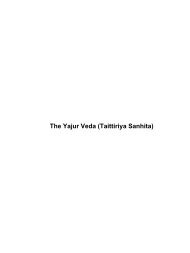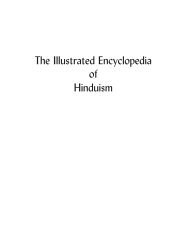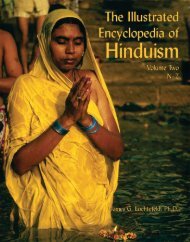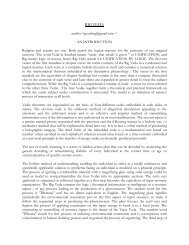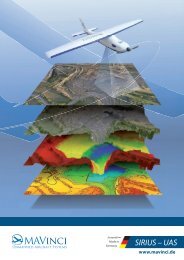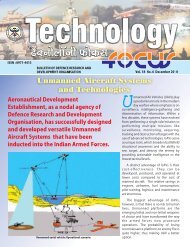A Concise Encyclopedia of Hinduism Klaus K Klostermaie
You also want an ePaper? Increase the reach of your titles
YUMPU automatically turns print PDFs into web optimized ePapers that Google loves.
Lava 104<br />
Lava<br />
The younger <strong>of</strong> the twin sons <strong>of</strong> Räma<br />
and Sïtä, later King <strong>of</strong> Ÿrävastï. (See also<br />
RÄMÄYAŒA.)<br />
liberation (mok•a, mukti)<br />
With the acceptance <strong>of</strong> the notions <strong>of</strong><br />
SAßSÄRA and rebirth, the major preoccupation<br />
<strong>of</strong> Hindus became liberation<br />
from the cycle <strong>of</strong> birth and death. The<br />
Upani•ads call the Vedas ‘unsafe boats’<br />
because they are unable to carry one to<br />
‘the other shore’. The Vedänta and<br />
most other systems are primarily concerned<br />
with teaching paths to liberation<br />
from rebirth. They agree on the necessity<br />
to neutralize KARMA (2) and to detach<br />
oneself from desire. They differ in the<br />
roles ascribed respectively to ritual<br />
(karma), devotion (BHAKTI) and insight<br />
(JÑÄNA). They also disagree on the possibility<br />
<strong>of</strong> reaching liberation while still<br />
in a body (jïvanmukta) and on the condition<br />
<strong>of</strong> the liberated (mukta): while<br />
ŸA¢KARA (2) teaches complete loss <strong>of</strong><br />
individuality in the merging <strong>of</strong> the liberated<br />
with BRAHMAN, RÄMÄNUJA and<br />
other theistic Vedäntins speak about an<br />
eternal individual existence in the company<br />
<strong>of</strong> the highest God.<br />
life (ayus)<br />
Hindus have always considered life as<br />
one, making distinctions in degrees only<br />
between the various forms <strong>of</strong> life.<br />
Rebirth could take place in any form <strong>of</strong><br />
life: plant, animal, human or divine.<br />
Human life was always considered special<br />
as the only form <strong>of</strong> life in which<br />
LIBERATION from rebirth could be<br />
gained. As regards the Hindu attitude<br />
towards life, there were two contrary<br />
opinons: the one, represented by Kø•æa<br />
in the Bhagavadgïtä, devalues physical<br />
life as just a garment <strong>of</strong> the spiritual<br />
soul, which can be changed at will. The<br />
other, considering ahiƒsä (not killing)<br />
as the highest duty, would take great<br />
care <strong>of</strong> life in all its forms and consider<br />
it sacred. The Hindu life sciences<br />
(AYURVEDA) were highly developed and<br />
had as their aim the preservation and<br />
prolongation <strong>of</strong> life.<br />
light<br />
the many terms used for light (jyotis,<br />
prabhä, prakäÿa, pratibhä, dïpti, känti,<br />
ÿobhä etc.) and the appellation <strong>of</strong> the<br />
highest experience as ‘enlightenment’<br />
indicate the great importance that light<br />
and everything connected with it have<br />
in Hindu thought. One <strong>of</strong> the oldest and<br />
best-known Vedic prayers asks to be led<br />
‘from darkness to light’ and the obligatory<br />
GÄYATRÏ mantra asks the SUN to<br />
illumine the mind. Not only was Sürya<br />
widely worshipped (sun temples used to<br />
be quite frequent in the Middle Ages),<br />
but Vi•æu also has a solar background.<br />
All the major gods have names that<br />
express light, splendour, brightness<br />
(Prakäÿätman, ‘self-luminous’; Bhäskära,<br />
‘sunlike’, jyotis, ‘light’) and the ultimate<br />
condition is described in terms <strong>of</strong> a<br />
light-experience.<br />
lïlä (‘play’, ‘sport’)<br />
The creation <strong>of</strong> the world by God is<br />
described as lïlä because it does not<br />
serve a purpose for God. Kø•æa’s dealing<br />
with the GOPÏS, especially RÄDHÄ, is<br />
called lïlä, divine playfulness.<br />
liöga (1)<br />
(‘sign’, ‘characteristic’, ‘token’)<br />
In logic, the predicate <strong>of</strong> a proposition.<br />
liöga (2)<br />
The male organ.<br />
liöga (3)<br />
The aniconic symbol under which Ÿiva<br />
is most <strong>of</strong>ten worshipped. The twelve<br />
JYOTIR-LI¢GAS are supposed to have




